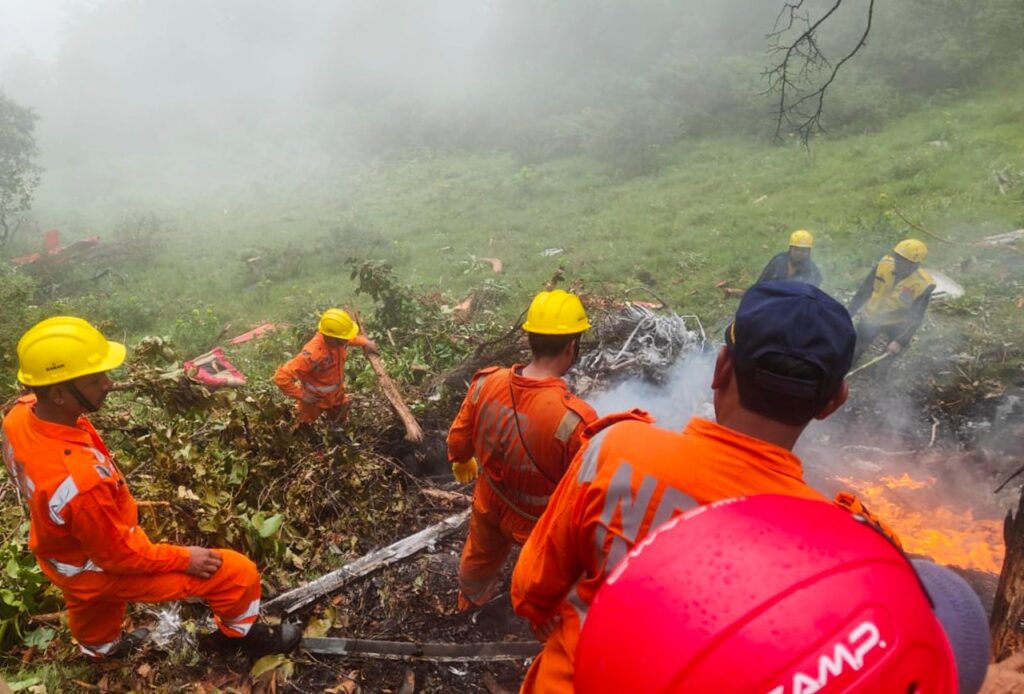Seven people, including a toddler, died in a helicopter crash near Kedarnath, Uttarakhand, raising new concerns over flight safety in the Himalayas.

Uttarakhand state, IN. (WE) — A helicopter carrying Hindu pilgrims crashed in India’s northern Uttarakhand state on Sunday, killing all seven people on board. The crash happened near the Himalayan temple town of Kedarnath. Officials confirmed that the aircraft took off at 5:30 a.m. local time from Kedarnath and was headed for Guptkashi, just 37 kilometers away. It crashed shortly after takeoff.
The victims included the pilot, Captain Rajveer Singh Chauhan, and six passengers: Vikram Rawat, Vinod Devi, Trishti Singh, Rajkumar Jaiswal, his wife Shraddha Jaiswal, and their two-year-old daughter, Kashi. Officials said a fire followed the crash, burning the bodies severely.
State Disaster Response Force (SDRF) personnel reached the crash site quickly, despite the rugged and forested terrain. They worked alongside local police to recover the bodies and secure the site. The location is remote and difficult to access, which delayed recovery efforts.
Authorities suspect poor weather caused the crash. Sudden changes in visibility and wind are common in the Himalayas, especially around Kedarnath, which sits at an altitude of 3,584 meters (11,759 feet). These conditions pose serious challenges for helicopter flights.
Chief Minister Pushkar Singh Dhami expressed condolences on X. He called the crash “very sad” and promised a full investigation. “Prayers for the departed souls and strength to their families,” he wrote.
Kedarnath is one of the four sacred sites in the Char Dham Yatra, a major Hindu pilgrimage. Thousands visit during summer. The terrain is steep and difficult, so many pilgrims choose helicopters over the trek. Many older adults and wealthier pilgrims opt for helicopter services to avoid the strenuous mountain trek.
However, air travel in the region is risky. In June, a helicopter made an emergency landing on a highway after a technical failure. The pilot sustained injuries, but the five passengers were safe. In May, a crash in Uttarkashi killed six people, including the pilot. Only one person survived.
Sunday’s tragedy marks the fifth helicopter accident in Uttarakhand in less than two months. Indian media outlets like NDTV and Times of India highlighted this alarming trend. These repeated crashes raise concerns about aviation safety in India’s hill states.
The Directorate General of Civil Aviation (DGCA) launched an investigation. Officials are examining the black box and flight logs. A team of engineers and aviation experts visited the site. Investigators are focusing on weather conditions, pilot actions, and mechanical issues.
The helicopter belonged to a private charter company licensed for pilgrimage flights. The company’s name has not been released yet. Authorities are reviewing its maintenance records and operating procedures.
This crash comes just days after an Air India flight from Dubai crashed while landing in Ahmedabad. That crash killed all but one of the 242 passengers. The plane also struck residential areas, killing people on the ground.
Read More:
- IRGC Confirms Death of Seven Top Aerospace Force Commanders in Israeli Strike; Khamenei Appoints Majid Mousavi as New Chief
- Iran Launches Missile Barrage on Israel Following Israeli Strikes on Iranian Infrastructure
- Israeli Strikes Hit Iran’s Nuclear and Military Targets, Revolutionary Guard Chief Reported Killed
The Indian aviation sector now faces intense scrutiny. Watchdog Aviation Safety Network noted that while safety standards have improved, India’s expanding air traffic—especially in risky regions—needs stricter oversight. Helicopter travel in places like Uttarakhand demands better planning and regulation.
The Ministry of Civil Aviation will audit all helicopter operators in the region. Officials will check pilot qualifications, emergency readiness, and aircraft conditions. Authorities may also install advanced weather monitoring and radar systems near key pilgrimage zones.
The victims came from various parts of India. The Jaiswal family was from Varanasi, while the other victims lived in Uttar Pradesh and Rajasthan. The Uttarakhand government announced compensation of ₹5 lakh (around $6,000) for each victim’s family.
Public reaction has been one of grief and growing concern. Social media users questioned the safety of helicopter services in Himalayan regions. Many asked whether the government is doing enough to prevent such accidents. Pilgrimage groups and safety advocates have demanded stronger regulations.
Prime Minister Narendra Modi addressed the tragedy during a speech in New Delhi. “Every life lost in such accidents is a national loss,” he said. “The government will act decisively to improve safety.”
The Prime Minister’s Office confirmed that central agencies are coordinating with state officials. A task force is reviewing accident trends in the region and drafting new guidelines for mountain aviation.
Despite the risks, helicopter services will likely remain important in Uttarakhand. In recent years, over half a million pilgrims have used air services to reach the Char Dham sites. Poor road conditions and steep paths make air travel an attractive alternative.
Still, safety must take priority. Aviation in challenging terrain requires careful planning. Weather forecasting tools, experienced pilots, and well-maintained aircraft are essential. If any of these fail, the cost is often human lives.
This latest crash shows the urgent need for reform. Policymakers must reassess the balance between convenience and safety. Religious tourism is growing, and infrastructure must keep up—not just in volume, but in standards.
India must also learn from international practices. In places like Nepal and Alaska, which also face mountain aviation challenges, authorities enforce strict flying rules. India could adopt similar strategies. Limiting flights during poor weather, enhancing pilot training, and installing better navigation systems could save lives.
For the families of Captain Chauhan, the Jaiswals, and others, this tragedy leaves a lasting void. No investigation or compensation can undo the loss. But meaningful change can prevent others from experiencing the same pain.
As the nation grieves, the focus must shift to action. The hills of Uttarakhand are sacred, and so is every life that visits them. Ensuring safe passage is not a luxury—it’s a duty.